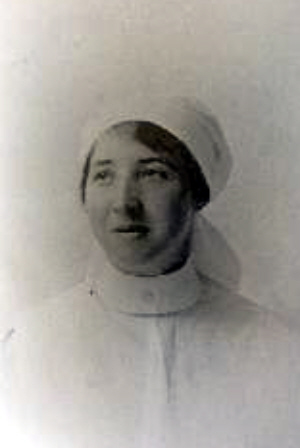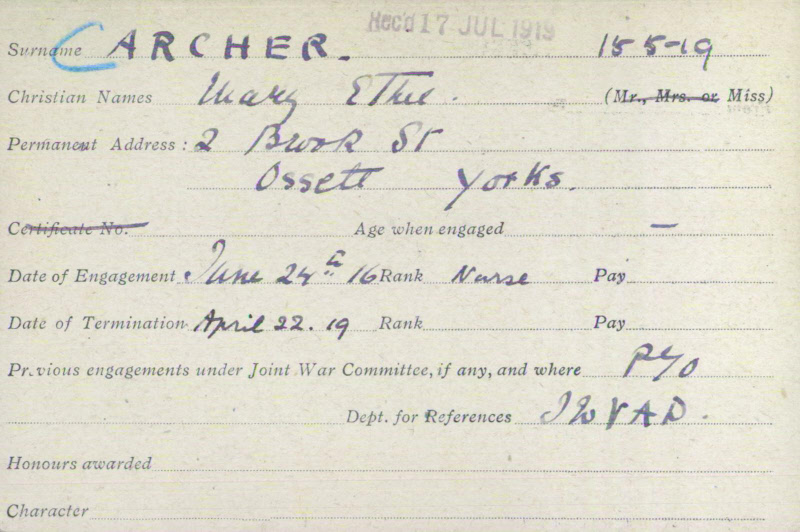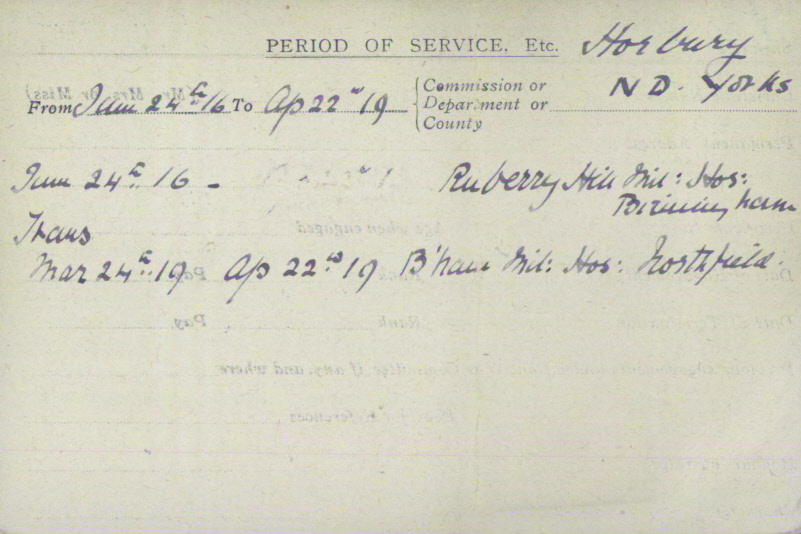
Mary Ethel Archer was born in Ossett in early 1886 the youngest child and second daughter of John Henry Archer and his wife Elizabeth (nee Batty) who married in late 1873. Mary Ethel was the youngest of four children, two sons and two daughters, born in Ossett to the couple between 1874 and 1886.
Sadly, John Henry, a carpet weaver, died in late 1888 aged 38 years leaving his widow, Elizabeth, with four children aged between 2 and 14 years of age. In 1891, widow Elizabeth and her four children were living at 5, Green Road, Ossett. Elizabeth was working as a burler in a mill and the two elder children, Willie and Annie, aged 17 and 13 years, were also millhands. Mary and youngest brother, James, were both still at school.
By 1901, the situation was much the same with Elizabeth and her four children still living at home on The Green. However eldest son, Willie or William, was now a pork butcher and his younger brother was working with him as an apprentice. Mary Ethel, aged 15, was working as an athletic machinist.
By 1911, the eldest two children had left their home on The Green. Their widowed mother, Elizabeth, was now 59 years of age and her youngest son, James Archer, aged 29, was a pork butcher on his own account whilst his younger sister, Mary Ethel, aged 25, was a rag sorter in a local mungo mill.
In 1913-14 James Archer was living on Brook Street, Ossett, and it was this address which Mary Ethel registered when she volunteered to serve with the Red Cross Voluntary Aid Detachment (V.A.D.). County branches of the Red Cross had their own groups of VAD volunteers and over time each of those volunteers be came to be known as a “VAD.”
Made up of men and women, the VADs carried out a range of voluntary positions including nursing, transport duties, and the organisation of rest stations, working parties and auxiliary hospitals. At the outbreak of the war, many people were inspired to train to help the sick and wounded. Women needed to be taught first aid, home nursing and hygiene by approved medical practitioners. VADs had to pass exams to receive their first aid and home nursing certificates. VADs carried out duties that were less technical, but no less important, than trained nurses. They organised and managed local auxiliary hospitals throughout Britain, caring for the large number of sick and wounded soldiers.
Mary Ethel Archer was engaged as a VAD nurse on 24th June 1916 and served for a period of almost three years until the termination of her engagement on 22nd April 1919. For most of her period in service Mary Ethel was stationed at the Rubery Hill Military Hospital in Birmingham. Her last month in service (April 1919) was spent at the Birmingham Military Hospital, Northfield.


Above: Nurse Mary Ethel Archer’s Service Record in WW1.
The urgent need for more suitable hospital accommodation forced the authorities to consider many alternatives. The Army Council specified the need for an extra 50,000 beds across the country, in established buildings with appropriate facilities, located near to a railway station. In consequence, the Asylum War Hospital Scheme was launched in January 1915. The asylums in the United Kingdom were sorted into 9 Groups. One asylum in each group would be cleared of its current patients, who would be transferred into the others in the Group. The emptied building would then be converted into a military hospital.
The Birmingham City Asylum at Rubery Hill, built in 1882, was chosen from the Midlands region’s Group 4 of asylums, together with its annexe at Hollymoor (Northfield). These became the 1st and 2nd Birmingham War Hospitals (BWH), with 1100 and 930 beds respectively. In all, 1334 patients were relocated to other asylums, including some very violent cases. The first military casualties were received on 5 July 1915 (Hollymoor) and 30 July 1915 (Rubery). After January 1 1918 Hollymoor became the Birmingham Special Military Surgical Hospital for orthopaedic cases. Some of the earliest medical staff in this specialism were Americans.1st BWH closed on 31 March 1919, having treated 20,000 casualties. 2nd BWH closed on the 1st March 1920, having treated 16,800 men. In the later stages of the war, Hollymoor had been converted into a specialist Orthopaedic Hospital.
21280 men passed through the gates of Hollymoor (Northfield) Hospital. They were not all totally happy. Sergeant J.H. Daly wrote to the Birmingham Post in September 1916 on behalf of Anzacs at the hospital. The medical treatment and nursing care were of the “best” but there was a problem about “freedom” and that “the out of bounds being within a few yards of the fences and, from what I can gather, we have to thank those of days gone by for this. It seems they were allowed more freedom but did not know a good thing when they had it. They came in at all hours and also the worse for drink; consequently those of us who follow have to suffer through men of that description.” 1

Above: Northfield Hospital, Birmingham in WW1.
Following her period of VAD service which continued after the end of WW1, Mary Ethel Archer returned to Ossett and on the 3rd April 1920 at Ossett Green Congregational Church, aged 34, she married 28 year old gamekeeper, James McCallum Watson. Bride and bridegroom gave their address as 5 Brook Street, Ossett and Mary Ethel gave her occupation as dressmaker. Her sister and younger brother were witnesses.
A child, James A. Watson, named after her younger brother, was born in Spring 1922. James McCallum Watson died in June 1972, aged 79 and Mary Ethel Watson died in September 1977, aged 88 years.
References
1. “History of Hollymoor Hospital”. Fay Crofts. Brewin. 1998